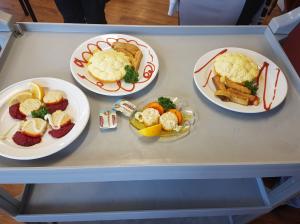The aged residential care programme is profiling some of the great work done in the sector. Here we look at how Enliven – which provides services to older people on behalf of Presbyterian Support Central – is using food moulds to improve residents’ meals.
Fiona Morrison, hospitality coordinator at Enliven, first came across food moulds in the aged residential care (ARC) sector in Australia four years ago. She says she was inspired by the idea and wanted to bring it to New Zealand as a way of making meals more appealing for residents unable to eat solid foods.
‘It’s a way of giving more dignity to people who need a modified diet,’ says Fiona. ‘They can have a plate that looks like a proper meal, so they don’t feel separate from everyone else.’
 A special setting agent is added to the pureed food before it’s cooked. It can then be poured into silicone food moulds and made to resemble the solid version of whatever the meal is – fish pie or lasagne, for example. The moulds are then put in the fridge or freezer to set.
A special setting agent is added to the pureed food before it’s cooked. It can then be poured into silicone food moulds and made to resemble the solid version of whatever the meal is – fish pie or lasagne, for example. The moulds are then put in the fridge or freezer to set.
‘You can do almost anything with it,’ says Fiona. ‘The results are outstanding. I’ve tasted quite a few meals and they taste just the same as the solid versions. The setting agent doesn’t contain any additives and the food holds its nutrition.’
Chefs from Enliven’s residential facilities attended a two-day workshop, where they were shown how to make meals using the food moulds. In order to encourage wider uptake, this year Fiona organised a competition, with chefs given two hours to produce a two-course meal with the moulds.
‘They really embraced it, and since then I’ve started to see it used more and more in our facilities. We’re making progress.’
She says the response to the meals from residents has been very positive.
‘We gave a woman a fully-formed meal for the first time in years – it was the first time in a long time she’d used cutlery. That was very satisfying. Another lady was sceptical beforehand, but she was blown away by it.
‘Most people clean their plates. They say it tastes better and is more appealing to look at. They’re putting on weight and say they’re feeling fuller and more satisfied with their meals. Family members are also impressed, as they can identify the different foods. It’s nicer for everyone.’
Fiona says the plan is to roll-out the use of food moulds more widely.
‘Three of our homes are already doing it full-time, and it will become an expectation that anyone on a modified diet will have meals made with food moulds.’
